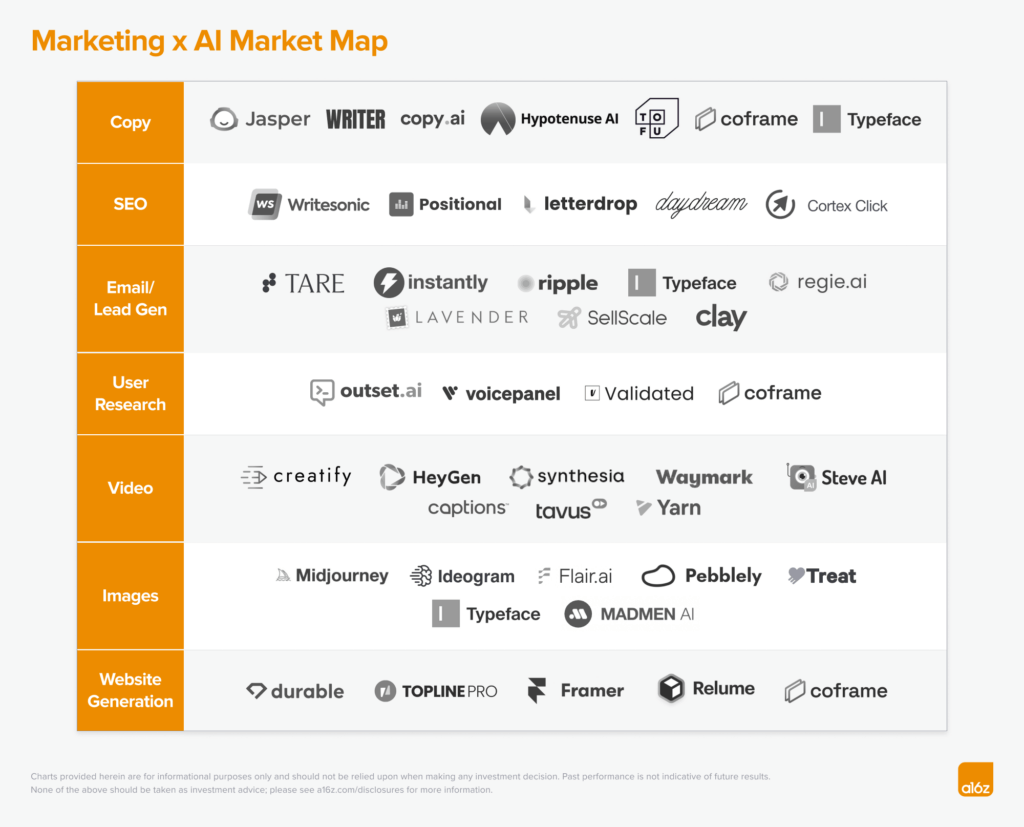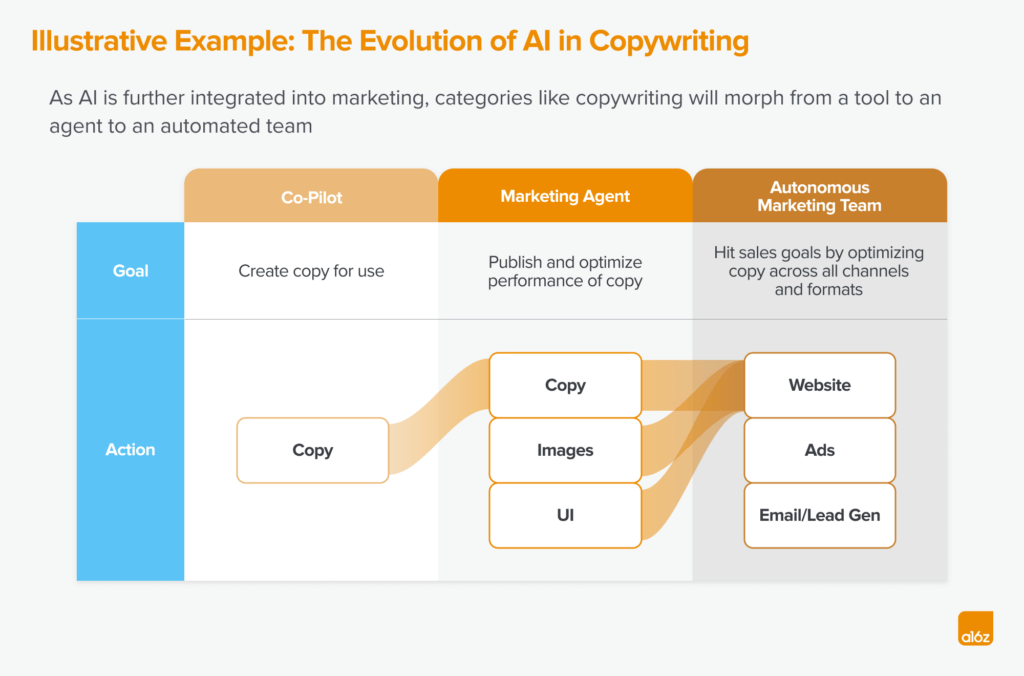
The world of film and video is on the brink of a major transformation, driven by the advancements in generative AI. This emerging technology promises to revolutionize how content is created, distributed, and consumed. But how exactly will this disruption unfold, and when can we expect to see its impact?
Marketing Use Cases Susceptible to Early Disruption
Content Marketing and Advertising for SMBs
Small and medium-sized businesses (SMBs) often struggle with the high costs and time requirements associated with content marketing and advertising. Generative AI can help by automating the creation of engaging video content, making it more accessible and affordable for SMBs to compete with larger enterprises.
Animation and Motion Graphics on the Low End of the Market
The production of animation and motion graphics has traditionally been a labor-intensive process. With generative AI, these tasks can be streamlined, enabling smaller studios and independent creators to produce high-quality animations and motion graphics at a fraction of the cost.
Corporate Video Production
Corporations rely heavily on video content for training, marketing, and internal communications. Generative AI can automate much of the video production process, allowing companies to produce more content faster and with greater customization to meet specific needs.
Micro Influencer and Brand Collaboration Videos
Micro influencers and brands can benefit from generative AI by quickly producing personalized collaboration videos. This can help them maintain a steady flow of content, keeping their audience engaged without the need for extensive production resources.

Social Media Content Creation for SMBs
Social media platforms thrive on a constant stream of fresh content. Generative AI can assist SMBs in creating diverse and engaging social media videos, enabling them to maintain a robust online presence without dedicating significant time and resources.
Real Estate Videography
Real estate agents and companies can use generative AI to create stunning property tour videos. AI can automate the editing process, highlight key features, and even generate virtual staging, making properties more appealing to potential buyers.
Other Use Cases Susceptible to Early Disruption
Television Production for Formulaic, Lower Quality Shows
Generative AI can handle the repetitive and formulaic aspects of lower-quality television production, freeing up human creatives to focus on more complex and high-value tasks.
Documentary Production
Documentary filmmakers can leverage AI to sift through hours of footage, identify key segments, and even generate narration scripts, significantly reducing the time required for production.
E-Learning and Educational Videos
The demand for e-learning content is growing, and generative AI can help meet this demand by automating the creation of educational videos. AI can generate interactive and personalized learning experiences, enhancing the effectiveness of e-learning.
Event Videography
Event videographers can use generative AI to quickly edit and produce highlight reels, ensuring that clients receive polished videos in a timely manner.
Music Videos for Emerging Artists
Emerging artists often lack the resources to produce high-quality music videos. Generative AI can democratize the process, allowing artists to create visually stunning videos that enhance their music and reach wider audiences.
Crowdsourced and Independent Production
Independent filmmakers and crowdsourced projects can benefit from generative AI by automating parts of the production process, reducing costs, and accelerating timelines.
Video Game Cutscenes and Trailers
The video game industry can use generative AI to create immersive cutscenes and trailers, enhancing the overall gaming experience and providing engaging promotional content.
The 4-Step Process of Film and Video Creation
The creation of film and video can be broken down into four main steps: Development, Pre-Production, Production and Post-Production. Generative AI has the potential to impact each of these stages in different ways.
- Development: AI can assist in scriptwriting, storyboarding, and concept development, providing creatives with new ideas and accelerating the initial phases of content creation.
- Pre-Production: AI can automate tasks such as casting, location scouting, and scheduling, making the pre-production process more efficient.
- Production: AI-driven cameras and drones can capture footage autonomously, while AI tools can assist directors and cinematographers in making real-time adjustments.
- Post-Production: AI can handle editing, color grading, visual effects, and sound design, significantly reducing the time required to complete a project.
The Circular Nature of Marketing and Content Creation

An analysis from A16Z on generative AI’s impact on marketing provides valuable insights into how these changes might unfold more generally. One of the key elements in successful marketing is integrating feedback and data from the market into the next iteration of content. This creates a circular process where the data coming out of the post-production process (i.e., distributing the content through various channels) informs the development process. This determines where new capital will be deployed, which channels will be reinvested in, and what the messaging will be. It is possible that we’ll see similar feedback loops built into film making, perhaps using the same kind of technology that Anamorph is using to create films like the one Gary Hustwit just showed at Sundance about Brian Eno.

All of these operations are undergoing dramatic changes as new tools impact how creatives and business leaders iterate on their marketing efforts.
Phases of Change in Marketing

According to A16Z’s analysis, there will be three phases of change in marketing due to generative AI:
- AI Copilots: These tools assist marketers by automating routine tasks and providing data-driven insights.
- Marketing Agents: These agents will handle more complex tasks, making strategic decisions based on market data.
- Autonomous AI Marketing Teams: Eventually, AI will take over entire marketing campaigns, from conception to execution, with minimal human intervention.
Speculation on Early Changes in Marketing
Drawing parallels between the marketing world and the video and film industry, we can expect a similar evolution. Initially, AI will serve as a production partner, assisting with specific tasks and streamlining processes. Over time, AI will achieve greater autonomy, eventually being capable of developing and producing content with minimal human input. This shift will have profound implications for the specific marketing use cases defined earlier:
- Content Marketing and Advertising for SMBs: AI copilots can help create personalized ads and content, increasing engagement and conversion rates.
- Animation and Motion Graphics: AI agents can produce complex animations quickly, allowing for more dynamic and appealing marketing materials.
- Corporate Video Production: Autonomous AI teams can handle entire corporate video projects, from scripting to final edits, ensuring consistent quality and faster turnaround times.
- Micro Influencer and Brand Collaboration Videos: AI can generate customized content for influencers, enabling them to maintain a steady stream of high-quality videos that resonate with their audience.
- Social Media Content Creation for SMBs: AI copilots can suggest content ideas, create posts, and analyze engagement metrics, helping SMBs optimize their social media strategies.
- Real Estate Videography: AI can automate video tours and virtual staging, making properties more attractive to potential buyers and accelerating the sales process.
In conclusion, the disruption of the film and video industry by generative AI is imminent, with marketing use cases being the first to feel its impact. By understanding the phases of change and leveraging AI tools, businesses can stay ahead of the curve and capitalize on the opportunities presented by this technological revolution.